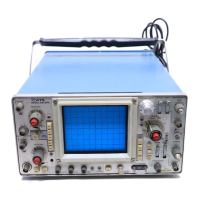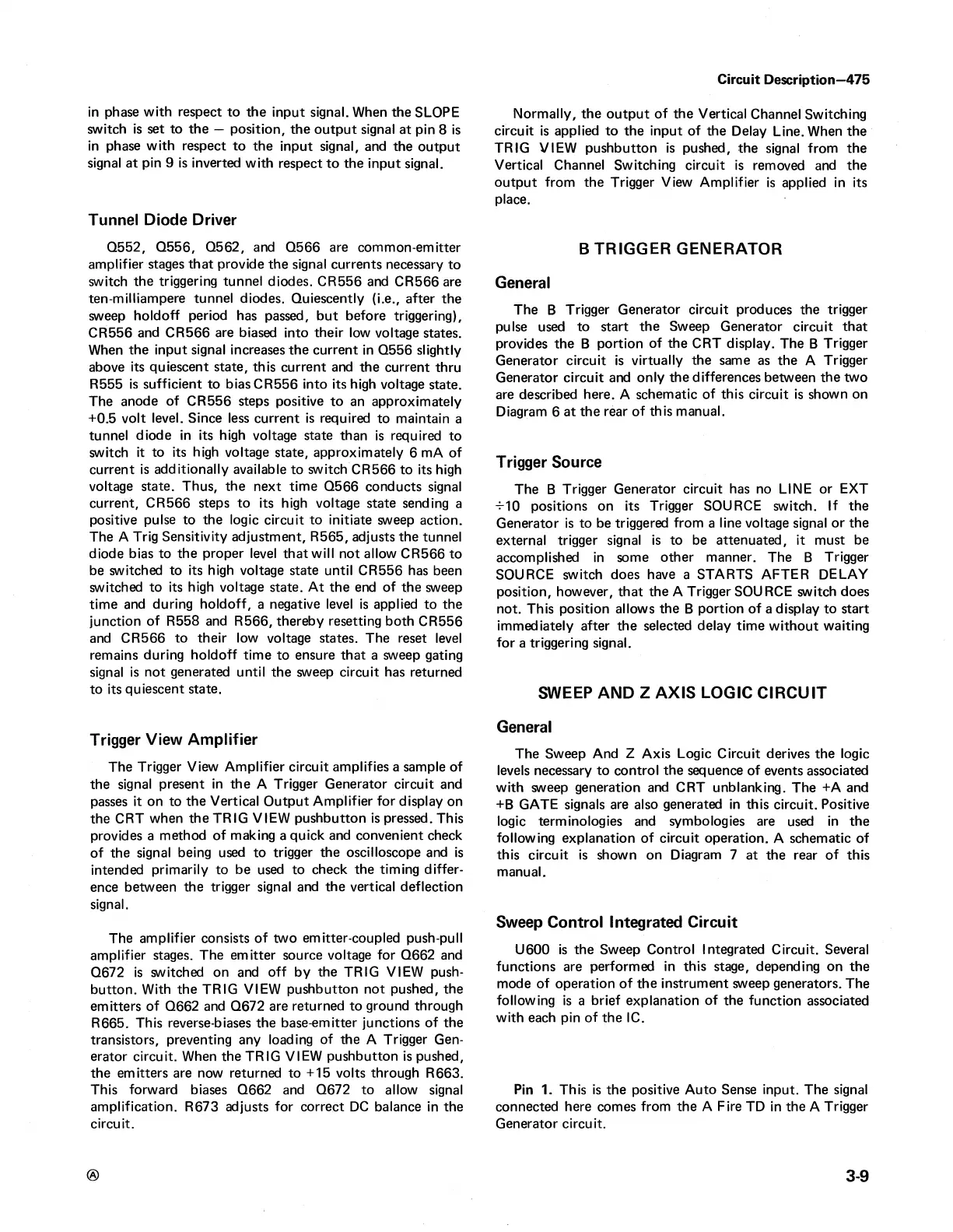Circuit Description—475
in phase with respect to the input signal. When the SLOPE
switch is set to the — position, the output signal at pin 8 is
in phase with respect to the input signal, and the output
signal at pin 9 is inverted with respect to the input signal.
Tunnel Diode Driver
Q552, Q556, Q562, and Q566 are comm on-emitter
amplifier stages that provide the signal currents necessary to
switch the triggering tunnel diodes. CR556 and CR566 are
ten-milliampere tunnel diodes. Quiescently (i.e., after the
sweep holdoff period has passed, but before triggering),
CR556 and CR566 are biased into their low voltage states.
When the input signal increases the current in Q556 slightly
above its quiescent state, this current and the current thru
R555 is sufficient to biasCR556 into its high voltage state.
The anode of CR556 steps positive to an approximately
+0.5 volt level. Since less current is required to maintain a
tunnel diode in its high voltage state than is required to
switch it to its high voltage state, approximately 6 mA of
current is additionally available to switch CR566 to its high
voltage state. Thus, the next time Q566 conducts signal
current, CR566 steps to its high voltage state sending a
positive pulse to the logic circuit to initiate sweep action.
The A Trig Sensitivity adjustment, R565, adjusts the tunnel
diode bias to the proper level that will not allow CR566 to
be switched to its high voltage state until CR556 has been
switched to its high voltage state. At the end of the sweep
time and during holdoff, a negative level is applied to the
junction of R558 and R566, thereby resetting both CR556
and CR566 to their low voltage states. The reset level
remains during holdoff time to ensure that a sweep gating
signal is not generated until the sweep circuit has returned
to its quiescent state.
Trigger View Amplifier
The Trigger View Amplifier circuit amplifies a sample of
the signal present in the A Trigger Generator circuit and
passes it on to the Vertical Output Amplifier for display on
the CRT when the TRIG VIEW pushbutton is pressed. This
provides a method of making a quick and convenient check
of the signal being used to trigger the oscilloscope and is
intended primarily to be used to check the timing differ
ence between the trigger signal and the vertical deflection
signal.
The amplifier consists of two emitter-coupled push-pull
amplifier stages. The emitter source voltage for Q662 and
Q672 is switched on and off by the TRIG VIEW push
button. With the TRIG VIEW pushbutton not pushed, the
emitters of Q662 and Q672 are returned to ground through
R665. This reverse-biases the base-emitter junctions of the
transistors, preventing any loading of the A Trigger Gen
erator circuit. When the TRIG VIEW pushbutton is pushed,
the emitters are now returned to +15 volts through R663.
This forward biases Q662 and Q672 to allow signal
amplification. R673 adjusts for correct DC balance in the
circuit.
Normally, the output of the Vertical Channel Switching
circuit is applied to the input of the Delay Line. When the
TRIG VIEW pushbutton is pushed, the signal from the
Vertical Channel Switching circuit is removed and the
output from the Trigger View Amplifier is applied in its
place.
B TRIGGER GENERATOR
General
The B Trigger Generator circuit produces the trigger
pulse used to start the Sweep Generator circuit that
provides the B portion of the CRT display. The B Trigger
Generator circuit is virtually the same as the A Trigger
Generator circuit and only the differences between the two
are described here. A schematic of this circuit is shown on
Diagram 6 at the rear of this manual.
Trigger Source
The B Trigger Generator circuit has no LINE or EXT
+10 positions on its Trigger SOURCE switch. If the
Generator is to be triggered from a line voltage signal or the
external trigger signal is to be attenuated, it must be
accomplished in some other manner. The B Trigger
SOURCE switch does have a STARTS AFTER DELAY
position, however, that the A Trigger SOURCE switch does
not. This position allows the B portion of a display to start
immediately after the selected delay time without waiting
for a triggering signal.
SWEEP AND Z AXIS LOGIC CIRCUIT
General
The Sweep And Z Axis Logic Circuit derives the logic
levels necessary to control the sequence of events associated
with sweep generation and CRT unblanking. The +A and
+B GATE signals are also generated in this circuit. Positive
logic terminologies and symbologies are used in the
following explanation of circuit operation. A schematic of
this circuit is shown on Diagram 7 at the rear of this
manual.
Sweep Control Integrated Circuit
U600 is the Sweep Control Integrated Circuit. Several
functions are performed in this stage, depending on the
mode of operation of the instrument sweep generators. The
following is a brief explanation of the function associated
with each pin of the 1C.
Pin 1. This is the positive Auto Sense input. The signal
connected here comes from the A Fire TD in the A Trigger
Generator circuit.
3-9

